Arif Janmohamed, Partner at Lightspeed Venture Partners, is joined by Sudheesh Nair, President at Nutanix, on the Strategy Stage to talk about the incredible journey of going from $0 to $4 billion in such a short amount of time.
From starting out as a few lines of code written at a Starbucks to becoming the fastest growing public enterprise cloud company of the last couple of decades, there’s so much to learn from Nutanix’s growth.
Sudheesh talks about growing and shifting from one gear the next, selling to “misfits” and why they’re beneficial at in the early stages, the best way to support salespeople and how they bring an Amazon-like experience inside the data center.
And if you haven’t heard: SaaStr Annual will be back in 2018, bigger and better than ever! Join 10,000 fellow founders, investors and execs for 3 days of unparalleled networking and epic learnings from SaaS legends like Jon Miller, David Steinberg, Jennifer Tejada, and Eoghan McCabe. If you don’t have tickets, lock in Early Bird pricing today and bring your team from just $999! (All ticket prices go up December 9th.) Get tickets here.
TRANSCRIPT
Announcer: Please welcome, Arif Janmohamed, partner of Lightspeed Venture Partners and investor in Nutanix, an enterprise infrastructure cloud platform.
Arif Janmohamed: All right, everyone, give it up for Sudheesh Nair, President of Nutanix. Come on out, Sudheesh.
Sudheesh Nair: Thanks, Arif.
Arif: How are you? Have a seat.
Sudheesh: Very well. How are you?
Arif: I’m well. Let’s have a little bit of fun here.
First of all, my name is Arif Janmohamed. I’m a partner Lightspeed Venture Partners. For those of you that don’t know us, we’re a global venture capital firm based out of Menlo Park, California with about $4 billion in capital commitments.
We’ve been really fortunate over the years to have partnered with the founders of Snapchat, or Snap nowadays, AppDynamics, MuleSoft, and of course Nutanix.
Let’s talk a little bit about Nutanix. It’s been a rocket ship. Founded in 2009, 2010, the fastest growing public enterprise cloud company of the last couple of decades, 4,500 customers, close to $1 billion revenue run rate, 2,000 employees worldwide, and this is amazing, the biggest tech IPO of 2016.
The coolest part about this…
[applause]
Arif: Thank you.
Sudheesh: Thank you.
Arif: This was accomplished in just seven years, and you guys are just getting started.
Sudheesh here has been with the company from earliest days when it was seven or eight employees, and you’ve seen that growth from whiteboarding, coding, eating pizzas, and now running a global organization.
You’re here to tell us about the journey. Tell us a little bit about yourself and Nutanix.
Sudheesh: January 10th, 2010, that’s when we wrote the first line of code. We were in a Starbucks, obviously. The company was basically around Starbucks because there is no office, there’s no WiFi. Just a point. If you buy a cup of coffee, they will kick you out around three o’clock.
Arif: You bought a couple of cups of coffee?
Sudheesh: [laughs] You got to buy more than one cup of coffee if you want to let them have you there for some time.
The company’s been on a good trajectory. We’ve been selling for the last five years. I started before the product was anywhere near completion. The first step was to try to do whatever it takes to get the first few customers in.
There is some idea that what we are trying to do make sense for the customer and then, most importantly, somebody is going to pay for it. If you think about that early days, the entire company was in engineering, customer support, marketing, sales, product management. Everything was just rolled into one ball.
My initial focus was to try to see if the product that we were building was going in the right direction.
Arif: The product market fit.
Sudheesh: The product market fit. Do we have to make some fundamental changes or not? We did have to, obviously.
Arif: Just for context, tell us a little bit about the trajectory. You started writing code, or the team started. I don’t think you wrote any code, did you?
Sudheesh: We did our 21st quarter. I’m still counting quarters. It’s like the kids. When they say, “How old is the kid,” people say, “36 months.” They don’t say three years. 21 quarters. We are at close to $1 billion billing run rate. Most importantly, we are still growing 80 plus percent, almost 90 percent year over year.
It was a vertical trajectory that we have taken. We did some readjusting financially. The first three quarters, we did close to eight million or so. After that, it was 50 million, plus…then it becomes 250. The next stop was close to a billion.
Arif: What does Nutanix do?
Sudheesh: [laughs] Exactly.
[laughter]
Sudheesh: What does Nutanix do? If you guys have any spare time, go to YouTube and search for Nutanix and Silicon Valley. The cast members from “Silicon Valley” explains what Nutanix does really well.
Listen, I think the early days of the company, our inspiration came from what Werner Vogels and Andy Jassy were doing from Amazon. We knew that Amazon was not selling box. They were saying, “Look, power is important for a venue like this, but chances are that power is not generated here. It’s consumed. It’s subscribed. You use more, you pay more. You use less, you pay less.”
Computing is equally important for a facility like this, but why should it be something that you cook up in your factory, in your kitchen? Let us be the producer, the developer, the distributor, the utility vendor for computing, so a large portion of customers could go there.
Our bet was that those who cannot go there for whatever reason should have a similar experience on prem. You have to bring that entire Amazon experience inside the data center, whether that’s data center they own or rent, it doesn’t matter.
To do that, a journey to make, and that was the idea of Nutanix, bringing that public cloud-like experience in the truest form inside the data center. We call it enterprise cloud. That’s what we are…
Arif: The enterprise cloud. Luckily, the cloud is going to be huge. 850, 250, a billion, that’s several stages of growth. Over the years, I’ve heard you talked about how the company has gone through several gear ratios or different segments.
Each of those segments or gears have had different stages of products, process, people. Walk us through the first gear.
Sudheesh: I’m a big fan of number three. Every time I’m trying to say something, I’ll think about one of the three points that I need to think about. If I were to go back and look at that, it’s like a car having three gears.
You have the first gear. Obviously, you’ve got to go to the first gear, not the gear that you enjoy while you’re driving. You want to get to the sixth or fifth gear, but unfortunately, you have to go through the first, second, and third, fourth, and all of that.
The first gear for this company, if you are to think about is 0 to, let’s say, 10 million. I’ll take that gear, and talk about those three things – product, people, and processes.
On product, we knew that the big aspirational bag that I just talked about, be like Amazon inside the data center, absolutely not something that we could do in the first shot.
More importantly, VCs won’t fund us…
[laughter]
Sudheesh: …long enough to build something like that. We had to build something, a part of it that makes sense for a large market and something that solves real problems so that the customers will pay for it.
On the product side, what we did was to make sure that the true north that we have that is going towards an Amazon-like experience doesn’t change.
Let’s take the first step, that might be left or right, it doesn’t matter, but that’s a step that we have to make. On that context, we took a product that was probably like 20 percent of what we need to do, which was in the context of storage.
Again, within the context of storage, we could not do everything that an EMC, or HP, or Dell does. We were able to do a few things. We got that product. We took that product and looked at and say, “Is this gonna do everything that an HP, or EMC, or an [inaudible 7:54] do?” Absolutely not.
We look for a use case, where this solves 80 percent of the problem. Now when you take a market and say, “I’m not gonna address 80 percent of that market. I’m gonna address 20 percent.” For the 20 percent, I want to address 80 percent of that problem with indirect.
Arif: MVP.
Sudheesh: MVP. The use case that we picked was virtual desktops. Now, the problem with that is when you take a smaller market like that, if want to do big business, you need to go broad, because a virtual desktop issue in New York will be similar to somebody in Bangkok, Beijing, or Belgium.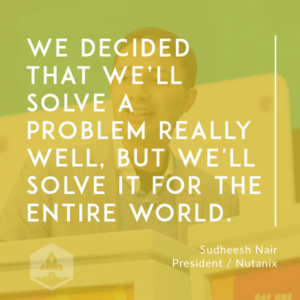
We decided that we will solve a problem really well, but we’ll solve it for the entire world. Obviously, when you make a decision like that, it’s very difficult problem for a start up company. I learned very quickly that selling, doing POC, shipping hardware into Thailand, to Singapore, to Belgium, it’s not as easy.
I learned a lot of useless things like [inaudible 8:55] , and hiring process, car allowance, all of those kinds of stuff. Our back office was really pushed but they did help take that MVP for that one use case and then sell everywhere. That allowed us to be really good at that one use case and sell.
On people, we went after, what I call misfits. Misfits are not defined well. They want to do a lot of things. They want to have a lot of wingspan. They will build their own code. They will build their own SKU that doesn’t exist. They will do whatever it takes to sell.
On processes, you might think like the early days if it’s full of misfits, we don’t have any processes. That’s not true, because we knew that we’re building a company of lasting value, we invest in a few things. One of them, for example, we said early on, we have to have a really good salesforce schema.
Hire someone to build the right way. Make sure that we exactly for compensation. We invest, expensify a whole bunch of things we did to make sure that we’re not messing up the foundation.
At the same time, it’s not like the processes were holding us back, these misfits were building processes as they were going a lot. That was the first gear.
Arif: Leading sales, how do you, how do you qualify for a misfit?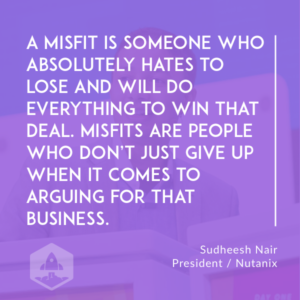
Sudheesh: A misfit is someone who absolutely hates to lose and will do everything that is legal and moral to win that deal. Obviously, ethics, and legality, and morality are important. Within that, this is somebody that is going to be so hard on themselves when they lose a deal that there is nothing you can do to make them feel worse.
Misfits are people who just doesn’t give up when it comes to arguing for that business from the customer or they’ll come back and yell at me or yell at the engineering because we didn’t do the right thing for the customer. Misfits don’t care. If marketing people say, “That’s not the presentation,” they’ll say, “Go to hell.” They will build their own presentation.
The messaging might be very different but they will keep trying. Misfits are great at that stage. The question is though, as the company scale, what do you do with them?
Arif: Tell us, you got to 10 million or 8 million, and you’ve got a band of misfits. This merry band of misfits is running around North America and now going international. What do you do now? You put it in second gear, what happens?
Sudheesh: Remember, if the company product was built to a full extent…Like I was saying, if you’re selling sausages and the hot dog is already built and all you have to do is to go hire a bunch of people, give the sausage and say, “Go to the streets and sell it. Here is the price. They will ask you, ‘Is it kosher?’ Say yes.” That’s the pitch.
You can hire 100 people and then drive them. That’s like you hire mercenaries. That is typically how sales is done. The problem to my point, we are building towards the true north and the first iteration of the product is a small chunk.
There’s going to be the next arc, and the next arc, and the next arc coming. We need these misfits to stick around so that they can take the next products early stage and then do what they did for the first stage. We had to preserve them. That’s number one.
Number two, you can’t just continue to run the company on misfits alone. The second stage on people to me was about builders. The difference between misfits and builders, builders are a lot more amenable to, for example, ecosystem building.
They know that these sellers are important. They know that you can’t just railroad a reseller and go close the deal and come back indirectly. They know that you may have to feed them a deal. In return, they will give you four or five opportunities through which you can actually expand your area of blast radius.
Misfits don’t really care about building a reference case from a winning customer. Builders do. Builders will win the deal, go back to them, and say, “Would you be willing to be on a video. Would you be willing to be on a conference like this and talk about why you picked Nutanix?”
Builders are happy to abate that information on Salesforce.com. From a process point of view, we added more and more automation around that time. One of the tools that we really like is Clari, for example. The other one is Aviso.
All these tools actually brought a whole lot more deal intelligence that allowed us to scale the deal management from a sales manager point of view.
The product, we continued to add. Again, because we started in the VDI Space, it became the blessing and the curse. We found that in that in the second gear that the identity of Nutanix was tied directly to that one thing.
We had to forcefully get out of that. You want to own that market but, at the same time, you don’t want to be tied only to that. There are a lot of lessons that we learned there as well.
Arif: There are many schools of thought around or probably two schools of thought around how you scale the sales team. One is, give someone two to three quarters. If they make their number, they’re in. If they don’t make their number, they’re out. At the scale and speed at which you guys are growing, you took a different approach. Tell us about that.
Sudheesh: Correct. If the company is growing 10 percent, less than 10 percent, 15 percent, you know that you can change a few things without impacting the momentum. It’s like F1 race. You go around the lap, after certain thing, you’re going to come to the pit stop, you change the tires then get back in there.
The problem with the company that is vertically taking off, which probably most of these companies are, you don’t have a pit stop but you have to change the tires. You have to, first of all, accept the fact that every time you change the tires, you are going to lose a whole lot.
Which means you cannot afford to treat salespeople like mercenaries. That is, you hire them, if they do right, great. If they missed a number, fire them, then you bring the next one on board.
You can’t do that because the company’s growth expectations are growing and it’s all built on the seller productivity. If I take two of these sellers out, the productivity comes down but the growth is not going to come down, which means that deficit continues to increase.
What do you? You have a choice. Now you have a choice to make sure that the sellers are succeeding. Instead of holding just the seller responsible, I made sure that the entire ecosystem feels responsible with the right KPIs.
For example, a seller is supported by an SE, an SDR, an ISR, a channel manager, a field marketing manager, an SE manager, a sales manager. There are six or seven people around them. If a seller is struggling, instead of simply saying, “Fire that person. Bring somebody else,” you’ve got to go look at why.
Is it possible that the corporate method that we developed in California doesn’t resonate well in Beijing?
Is it possible that all of our enablement was on YouTube and China doesn’t let you see YouTube? Is it possible that the marketing program that we rolled out goes completely against in one place? Maybe the channel partner that we’ve invested heavily doesn’t operate there. There are a lot of things that we can use.
Again, the tools like Clari allows us to see why a deal is stuck. When you see that, you go and then make that tweak. It could be a channel tweak, a marketing tweak, a messaging tweak. All of sudden, what happens is the seller knows the company never gave up when he or she was having a hard time.
The beauty, I’ve seen this consistently happening, when you don’t give up quickly on a seller, that seller becomes my go to person when the company’s in trouble.
When I have a hard quarter, I pick up the phone and tell that seller, “Mike, I’m in trouble. I need that deal.” I know for the next two weeks this person is not going to sleep. He or she is going to go out and bring that deal that is not even in the possibility because he or she doesn’t want to let the company down when we are having a hard time.
I’m not saying that all sellers are going to be successful. You always have to continue to look at the bottom of the pyramid. Just like how you don’t fire an engineer just because he or she wrote a code that has a bug.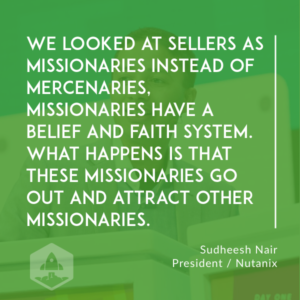
We looked at sellers as instead of mercenaries, we looked at them as missionaries, missionaries who are going there with a belief and faith system. What happens is, when you do that, these missionaries go out and attract other missionaries.
If you go to a sales organization where you’re the best sales guy, had amazing paycheck, guess what, the next quarter, the number is tripled.
Our missionary will go and say, “You know what, if you don’t want that to happen, come here.” I have consistently proved at Nutanix for the last five years that the best companies are the ones where the salespeople make money. Don’t be afraid to pay them. Don’t be afraid to put them on acceleration.
If they’re accelerating based on the productivity, the company’s made money. It’s OK for them to make money because they go out and bring the next best people.
Arif: Culturally, you had an attitude of supporting and mentoring your team. You also had an attitude of making sure that people made money. Talk us through a little bit about how you thought about setting quotas and how you thought about accelerating, etc.
Sudheesh: Yeah, absolutely. By no means do I mean to say that sales isn’t…Sales is probably the most quantifiable profession there is. Every 90 days, you know whether you’re a hero or a zero. There’s no way for me… I don’t have any second place finish.
Arif: Every 90 days, you know you’re a hero or a zero.
Sudheesh: Every 90 days, you know this. I have sellers who will come and tell me a long story on how they lost and we were the second best. Who cares?
Arif: Who cares?
Sudheesh: Second best is like as good as the last.
Arif: Steak knives.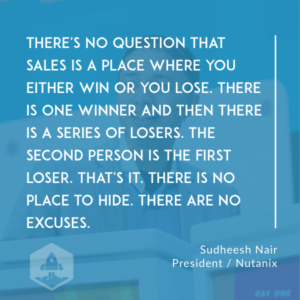
Sudheesh: There’s no question that sales is a place where you either win or you lose. There is one winner and then there is a series of losers. The second person is the first loser. That’s it. There is no place to hide. There are no excuses.
I don’t mean to say that there’s a long list of underachievers, but the point is instead of just jumping on their throat and yelling and screaming, we have figured out what is the reason and how can we enable them to go up, churn the bottom, not by firing them but elevating the least common denominators.
From a culture point of view, what it creates is a system where the productivity that we talk about. Every time you give them a quota, for us, it was very clear in terms of how that productivity model was built and we were pretty transparent about that.
We actually built the model and told everyone that here is how we’re going to measure you.” If you have a sales person, an SE, an ISR, an SDR and channel marketing, one fourth and one fifth, and all of that, this is how much it’s going to cost the company. Fully burdened cost for this company is going to be, let’s say, $700,000 and the margin is, let’s say, 60 percent.
This is how much net cash you’re going to bring. For this company to be profitable, to get to where we need to get to, you need to get to this number. This is the product we give more of. Once you get to buyoff, we are now able to show them and stack it up.
That productivity model is built on one thing. You don’t punish successes and reward failure, which is what a lot of companies do. Which is, if you are the top rep, guess what? Your quota has gone up. We don’t do that.
By holding them accountable and being transparent and without giving them too much surprises, we’re able to build that trust. I mean, again, trust is something that could go away if we do the wrong thing, but that trust in the last five years, I think allowed us to push the edge, do some experimentation like today.
This morning, I announced a new comp model and then I had some of the field’s best sellers jumping on the call to say, “Listen, guys, this comp model looks complicated, but don’t worry. This is not about the company going public and trying to screw us. In fact, if you do this right, I’ve done the calculation, we will make more money.”
Arif: Wonderful. You got to 100 million in a couple of years.
Sudheesh: Yeah.
Arif: Tell us about the next 800 million.
[laughter]
Sudheesh: See, I think this is a journey that is still going on for us in the sense that this journey of self discovery, so to speak. On the people side, we realize that from builders, now we need to go to scalers.
Now, scalers, the company’s DNA. Like most of the companies in this room, the company’s DNA is not built for gathering. We are hunters. We like going out there, getting into an account, calling names of the legacy, and saying how wrong they are, how stagnant they are, how archaic the architecture is, and here is the brand new thing. That’s what we love to do.
You have to understand. When you sell that, three or four years after, that customer, we are the legacy. We have to change that.
Second, we may have sold like one percent of the IT spend of a customer. There is 99 percent that is still going somewhere else. For that now, we need the sales force to stick around and then build account plans, build a checkpoint with the customer, a trajectory in terms of growth plan.
That is what companies like IBM, Oracle, and Cisco…This is exactly what we were poopooing and laughing at. Now, we need to learn from those companies and build it.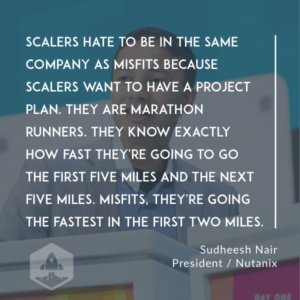
The thing about scalers, they hate to be in the same company as misfits because scalers want to have a project plan. They are marathon runners. They knew exactly how fast they’re going to go the first five miles and the next five miles. Misfits, they’re going the fastest in the first two miles.
Putting them all in the same tent becomes a huge challenge. What we have found is that you have to make sure that the respect is given to each three. For example, we have to make sure that the misfits understand why it is important for us to have the scalers in the same tent and vice versa.
Communication becomes one of the most important things that we have to do to build a diverse trend. Like I said, if the product is not changing, growth is somewhat predictable, probably we don’t need misfits and builders, we can just have scalers, but that’s not the case. A company that is not disrupting itself or innovating itself out of where it is now will die.
We need the misfits, but to land and expand, we need the scalers. We are going through that process of figuring out how best to bring them all into the same tent. What we’ve found is, again, the basic decency with which a company treats a seller…
Arif: Culture.
Sudheesh: Culture matters so much. Culture to me is like a piggy bank. During the good days you keep investing in it so that the bad days you can break it and use it.
The company has been going really well. I’m not saying that our culture is the best. I will know the culture when the company hits the tough times. Hopefully, the people will get us through that, they won’t jump ship the first moment there is a turbulence. It is an exciting journey. I’m learning. All of us are journeying, are learning as we go and grow.
Arif: How did process change?
Sudheesh: Process?
Arif: For the 800 million?
Sudheesh: Process, I think the biggest change has been the network. For example, we are a two tier distribution model. We have a distribution and resellers.
We had to make sure that the quotes that we were doing is now fully automated, which means that we have to build things like EDI, things that we just hated. Talking about an EDI system with companies like ABnet, ADEL, mass volume distribution, supply chain optimization, things that makes me want to puke.
Now, I need to go figure it out again. What happened is I found that you had to be really humble enough to go and hire people who have done this for the last 25 years and then make sure that you build that experience around you.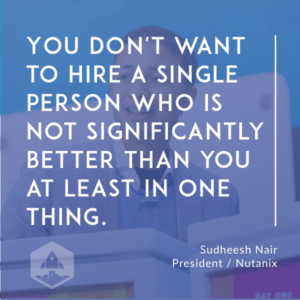
My philosophy when it comes to hiring over a period of time, early days I had my own ego and other stuff to deal with, insecurities and everything, but after four or five years, what I learned is you don’t want to hire a single person who is not significantly better than you at least in one thing.
When I look at my leadership team, I can point at each one of them and say that this person…Craig is significantly better than me in this thing. Mike is significantly better than me in this one thing. If I don’t see that, I try not to hire them.
What happens is when you have that collective IQ and if you remove the ego and insecurity from the team and make sure that you facilitate the communication, good things usually happen.
Arif: What’s keeping you up at night right now? You’re close to $1 billion in billings. Very few companies make it there. Congratulations. The next milestone is five.
Sudheesh: What keeps me up at night is that we don’t want to be a company that is complacent based on the success. I mean, we have to stay paranoid, we have to stay hungry.
The builders, the engineering, the product, and all of those guys as the company goes with the IPO and then unlocks, we have to make sure there will be a have and have not. There will be people who have been here long and people who are not being here long.
It is important for us to make sure that we constantly look at the top 20, top 30 percent and then make sure that they are taken care of. They are not going anywhere else, because we have found that the best people don’t work for money.
The best people work because they want to be making a difference. They have a say in which way the company is going. They want to be in a place where meritocracy still rules, bureaucracy doesn’t.
As the company gets bigger, all these things that is talked about becomes very, very difficult. This is an industry that is extremely brutal. I mean, BlackBerry, Nokia, Motorola, all of these companies, all it takes is one misstep and then all goes down.
Arif: Yeah, all goes down.
Sudheesh: What keeps me up at night is exactly that.
Arif: Last question, if you were to identify one mistake you made, only one…we don’t have another half hour, what would it be and what would you change?
Sudheesh: I mentioned it briefly. I think, experience or lack thereof is an interesting thing in my mind. I keep thinking about it. Experience can be a guardrail or a blinder.
That is, let’s say, I’ve done something 10 years ago. It did not work. If it didn’t work, I can let that thought become a guardrail and say, “You know what, it didn’t work, but the times are different. Let’s try it again. If it is still going that direction, let’s make sure we don’t go off a cliff.” It can also become, “It doesn’t work. Don’t worry about it. Don’t even try that.” It’s very difficult.
In my own journey, I think I’ve found that my own experience, my own ego, my own insecurity, all of those things, it took me a long time before I can let those things go and then truly embrace that there is no freaking way that I am going to get to what I need to get to this company without really bringing people and then letting them do what they do best. The best they can be as opposed to best that I want them to be.
Arif: You got here without getting even a gray hair. Congratulations.
Sudheesh: I have, trust me.
Arif: Look, we’re out of time. Thank you, Sudheesh. It’s been an incredible journey. Really looking forward to the next milestone. Thank you.
Sudheesh: Thank you so much. Thanks for the opportunity, Arif. Thanks for the team. I appreciate it. Thanks a lot.

